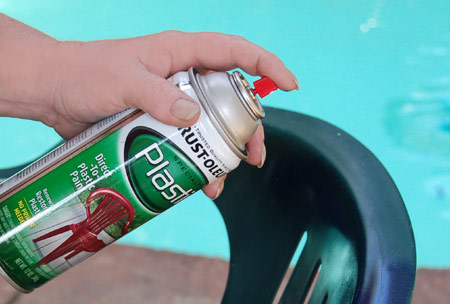How to and tips on using spray paint
Spray paints have come a long way in the last few years, especially if you use the Rust-Oleum range of spray paints. But as with every type of painting product, there are pros and cons and hints and tips that can be useful to know.
Working on so many different types of projects each and every month I get to try out a lot of new products. One of my ultimate favourites is the Rust-Oleum range. Most cheaper spray paints have more solvent than paint in a can, whereas Rust-Oleum have more paint and less solvent. If you haven't yet tried Rust-Oleum, buy a can and see for yourself.
Benefits of using spray paint (Rust-Oleum)
-
Far more coverage than conventional brushed-on paint - and without brush strokes.
-
Much faster to apply and dries in a fraction of the time.
-
Due to its solvent base, spray paint is far more durable than most other paints.
-
Spray paint is easy to use outdoors, with a drop cloth and some newspaper.
-
Specialty spray paints can be used to transform metal, wicker, plastic, resin and other surfaces.
- With a spray paint nozzle gun in hand, you can conquer the world, or at least, transform a piece of furniture without losing your mind to a million brush strokes.
-
Clean up is quicker – no brushes to rinse or buckets to wash.
-
Spray paint makes you feel like you are cheating - it makes painting projects so much easier!
Disadvantages of using spray paint (Rust-Oleum)
- Even with their wide colour range, the selection is limited when compared to conventional brush-on paints.
- Spray paint requires ventilated area in which to work. You can’t use it indoors unless the area is well ventilated.
- Spray paint is typically oil based, so clean up on your hands requires mineral spirits or really strong exfoliation.
- Spray paint is extremely toxic (therefore, wear a mask).
- A bad nozzle will spatter paint and ruin your day.
Guidelines for using spray paint (Rust-Oleum)
-
Shake the can and then shake it again. You can never shake enough, especially when using for the first time.
-
Always spray 30cm away from your piece, and move gently from left to right as you spray.
-
Two thin coats is better than one thick coat, and it prevents drips.
-
Have a scrap piece of wood handy to check that the paint is mixed before starting, especially when using metallic or stone sprays.
- If the valve becomes blocked, shake the can and hold upside - give it a couple of spray to clear the valve. Always keep a couple of spare nozzles handy from old cans just in case to have a faulty nozzle - it's easy to swap them.
-
Quality varies, so I mostly use Rust-Oleum spray paints.
-
Dispose of your cans properly at a toxic waste disposal sites.
You can buy Rust-Oleum products at most hardware stores countrywide.

